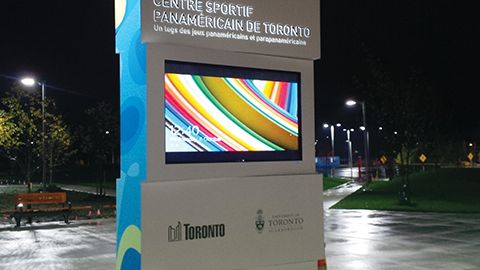
Gregory Signs also arranged fibre optic connectivity for the facility’s outdoor digital signage. Photos by Gerald Querubin, courtesy Entro
The already rapid pace of the project did not slow down, as PCL had to turn the building over to the Pan Am committee by summer 2014, so it could be opened, operated and tested for a minimum of one year before the games.
“That was really cutting it close for signage,” says Grose, “especially since this system involved a unique variety of more than 1,000 different signs, from stop signs to high-definition (HD) outdoor screens and everything in between. And sometimes additional signs were needed beyond the original plan, even though the end date could not be changed.”
Gregory Signs continued installations as the building became ready, in some cases on unfinished surfaces to meet PCL’s schedule and occupancy requirements.
“Moving forward, PCL is no longer involved in the building, so we work directly with the Pan Am committee and TPASC’s operators,” Grose explains. “There is also a list of signs to be installed after the games.”
One advantage—and why PCL selected Gregory Signs in the first place—was the ability to handle almost all production in-house. Only photopolymer-based tactile signs featuring Grade 2 braille and digital signage displays were sourced from outside suppliers.
“If we hadn’t been able to handle as much of the work in-house, we may not have met the timeframe,” says Grose. “You have greater control of the schedule when you can control production internally.”
Shaping the landscape
As mentioned, while TPASC is now open and fully operational, the sign system continues to be updated. One of Grose’s most recent efforts has been to introduce TPASC employees to a specialized company that can train them to program the digital signage network.
“We’re not a programming company ourselves, so we got the right people in to help,” he says. “It’s a question of ongoing customer support. Not a lot of sign companies get involved to this level, but we’re happy to participate, as we don’t want to leave our clients with no means to take advantage of electronic displays to their fullest extent. And it’s great to be part of a state-of-the-art building that will help shape the Toronto landscape for years to come.”
Entro, for its part, is also overseeing the implementation of a broader urban wayfinding system for the games across Toronto, Hamilton, Milton, the Niagara Region and Minden Hills, Ont. The pace remains rapid, as the games will begin on July 10.
With files from Entro and Gregory Signs & Engraving. For more information, visit www.entro.com and www.gregorysigns.com.






